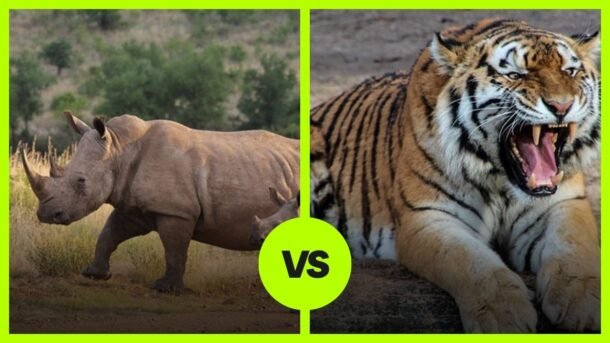Intro: The Age-Old Question
The natural world is filled with fascinating and often hypothetical battles, with one of the most intriguing being a matchup between a tiger and a rhino. These two formidable animals represent the pinnacle of power in their respective habitats, but how would they fare against each other? This comprehensive analysis delves into various aspects of this hypothetical encounter.
Size and Strength
Tiger
- Physical Attributes: Tigers are among the largest and most powerful of all big cats. An adult Siberian tiger, the largest subspecies, can weigh up to 660 pounds and measure up to 12 feet in length, including the tail.
- Strength: Tigers possess incredible strength, especially in their forelimbs, which they use for capturing and holding down prey.
Rhino
- Physical Attributes: Rhinos are massive, with the larger species like the white rhino weighing up to 2,300 pounds and measuring over 13 feet in length.
- Strength: The rhino’s most notable feature is its horn, which it uses for defense. Their body is built like a tank, giving them immense strength and resilience.
Hunting and Fighting Abilities
Tiger
Hunting Skills
Stealth and Strategy: Tigers are masters of stealth, using their striped coat as camouflage to blend into the forest. They patiently stalk their prey, often for hours, minimizing movement and using the terrain to their advantage. This stealth approach compensates for their lack of stamina for long chases.

Attack Method: When close enough, tigers launch a rapid and powerful attack, aiming to surprise and overpower their prey. They often target the neck or throat, using their powerful jaws to deliver a fatal bite.
Prey
Diet Diversity: Tigers primarily feed on medium to large-sized herbivores. In different regions, this includes sambar deer, chital, gaur, and water buffalo. Their ability to take down large prey is a testament to their strength and predatory skills.
Opportunistic Hunting: While rare, tigers have been known to attack young or weakened members of larger species, such as small elephants and, occasionally, rhino calves. These attacks are more about opportunity and necessity than preference.
Combat Skills
- Single Combat Expertise: Tigers, being solitary hunters, have evolved to handle their prey alone. They rely heavily on their physical prowess, including their powerful forelimbs, sharp claws, and teeth.
- Adaptability: Their combat style can vary based on the prey. They exhibit remarkable adaptability, changing tactics based on the size, strength, and behavior of their target.
Rhino
Defensive Skills
Formidable Defense: The rhino’s primary defense mechanism is its sheer size and tough, thick skin, which is difficult for predators to penetrate. The skin can be up to 1.5 inches thick, acting as natural armor.

Horn as a Weapon: The horn, made of keratin, is a powerful tool for defense and deterrence. Rhinos use it effectively against predators and in battles with other rhinos.
Natural Enemies
- Few Threats in the Wild: Due to their size, adult rhinos have few natural predators. However, young or sick rhinos can be vulnerable to attacks from large predators like tigers.
- Human Threats: The most significant threat to rhinos is poaching and habitat loss due to human activities.
Combat Skills
Charge and Impact: Rhinos are known for their aggressive charge, capable of reaching speeds of up to 30-40 mph. This is their primary method of attack, using the horn and their massive body as battering rams.
Defensive Positioning: When threatened, rhinos are likely to position themselves to use their size and horn most effectively, often trying to keep the threat in front of them where they can charge or strike with their horn.
Commonly Asked Questions
- Can a Tiger Kill a Rhino?: While it’s theoretically possible, especially in the case of young or weakened rhinos, it’s highly unlikely due to the size and defense of a healthy adult rhino.
- Do Tigers Hunt Rhinos?: Tigers generally do not hunt adult rhinos but may attack young or weak individuals.
- Conservation Efforts: Both tigers and rhinos are endangered species, protected under various laws like the Rhino and Tiger Conservation Act.
Who Would Win: Tiger vs. Rhino
Theoretical Encounter
In a hypothetical battle, the outcome would largely depend on numerous factors including the age, size, and health of the individual animals. A fully grown, healthy rhino would have a significant advantage over a tiger due to its size, strength, and defensive horn.
Factors to Consider
- Terrain: The environment could play a crucial role. In a dense jungle, a tiger might use its agility and stealth more effectively.
- First Strike: If a tiger manages to leverage a surprise attack, it might inflict significant damage. However, penetrating the rhino’s thick skin would be challenging.
- Endurance: Tigers may have greater endurance in a prolonged fight, but the sheer power of a rhino could end the battle quickly.
Percentage Chance of Winning
Based on the analysis of size, strength, and fighting abilities, the likelihood of winning in this hypothetical matchup is skewed towards the rhino. However, the tiger’s agility and predatory skills cannot be entirely discounted.
- Rhino’s Chance of Winning: 80%
- Tiger’s Chance of Winning: 20%
Conclusion
In the wild, it’s improbable for these two animals to engage in combat as they inhabit different niches in the ecosystem. However, if such a confrontation were to occur, the rhino, with its formidable size and strength, would likely have the upper hand. This analysis underscores the unique adaptations and strengths of both these magnificent animals and highlights the importance of their conservation.
For more fascinating animal matchups and insights, check out these recommended reads from our website:
- Explore the intense battle between two of the jungle’s most formidable creatures in “Tiger vs. Komodo Dragon: A Battle Between Predators of Different Realms“.
- Dive into the dynamics of size, strength, and strategy in “Serval vs. Tiger: A Mismatch of Size, Strength, and Strategy“.




